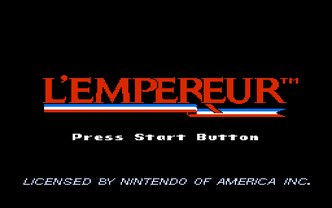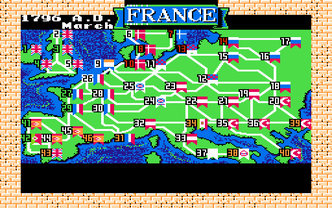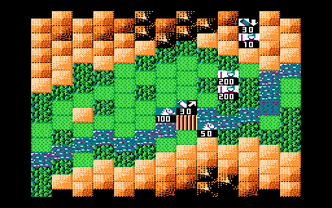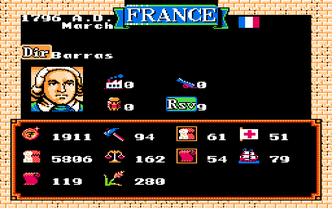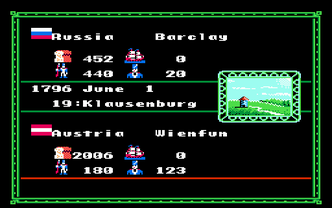Navigation:
L'Empereur Nintendo
L'Empereur (ランペルール, Ranperūru) is a turn-based strategy video game for the Nintendo Entertainment System released by the Koei company in 1989.
The player chooses from one of four scenarios (or loads a saved game) that starts off in different years. The earliest scenario has Napoleon as a Commander in Marseille in 1796, and historically has him poised for his invasion of Italy. The second scenario has Napoleon in St. Malo as Commander-in-Chief in 1798. The third scenario, arguably the easiest starting point, has Napoleon as First Consul of France in 1802. The final scenario, which has Napoleon as Emperor, starts in 1806, and in this mode the player can control Napoleon's siblings and stepson as well.
Each turn lasts one full month per year, for a total of 12 turns per year. Although the years change every January, it's in March that most gameplay elements are affected by the game engine (such as the drafting of soldiers and officers, the termination of certain diplomatic agreements, and the collection of taxes).
In each month, the player (as well as all other commanders of cities) manage military and civil affairs for their respective cities. Additionally, every three months (starting in March), national leaders may carry out diplomatic and national affairs.
The crux of the gameplay rests in the actual battles, which take place on special tiled battlefields arranged in hexes. Opposing commanders place their armies accordingly, and then maneuver them around the battlefield into battle. Defenders have the responsibility of keeping city hexes under control while repelling the enemy while attackers have to either take all the city hexes or annihilate the defenders before they run out of food and are forced to retreat. A number of terrain features add depth to the gameplay, such as swamps, forests, hills, mountains, rivers, and tundra. Also, the seasons and weather affect battle, with invasions in the winter months causing bodies of water to freeze over and generally slowing the movement of troops. Troops on frozen water can fall if they are bombarded, as happened at the Battle of Austerlitz.
Each army may consist of three types of units: basic infantry (which can build and explode bridges), cavalry (which can charge an enemy, allowing them to repeatedly attack a unit in a single turn), and artillery (which can bombard enemies from afar). Each unit has three main factors determining how well they fight: strength, which can go up to 200 soldiers per unit; training, which affects how accurate the unit's attacks are and the speed at which the unit moves; and morale, which determines how well the unit is at absorbing attacks and avoiding falling into crippling disorder. Additionally, the unit's commanding officer, with ratings from A to D in leadership and experience commanding a unit of that type (infantry, cavalry, artillery), affects the unit's attack/defense power and morale.
As Napoleon, the player's basic goal is to conquer Europe, but for many players that could be a daunting task as both time and the sheer size of the task require very patient planning and careful strategizing to accomplish this. Each scenario presents an easier goal to achieve, which is basically to have Napoleon be promoted from Commander to C-in-C to First Consul to Emperor.
